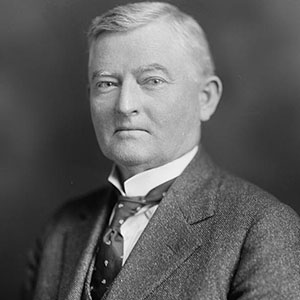John Nance Garner was the 32nd Vice President of the United States, serving under President Franklin D. Roosevelt from 1933 to 1941. Known as “Cactus Jack,” Garner was a skilled back-room politician, previously serving as Speaker of the U.S. House of Representatives.
Early Political Career
John Nance Garner Garner was born on November 22, 1868, in a log cabin near Detroit, Texas. He attended Vanderbilt University in Nashville, Tennessee, but never graduated. He eventually studied law and was admitted to the bar in 1890. After serving as a county judge, Garner was elected to the Texas House of Representatives. During his tenure, Garner was a vocal supporter of the prickly pear cactus as the Texas state flower, earning him the nickname “Cactus Jack.”
In 1902, Garner was elected to the U.S. House of Representatives to serve the 15th congressional district, a largely rural Texas district. In 1929, Garner was selected to be the Democratic minority floor leader. Two years later, he was selected as Speaker of the House.
Vice-Presidency
In 1932, Garner sought the Democratic Presidential nomination. While Roosevelt was the frontrunner, he needed approximately 100 votes to secure the two-thirds required for nomination. Garner reached an agreement with Roosevelt and joined his ticket as Vice President.
Much like his predecessors, Garner did not play a central role in the administration’s policy formulation, including the New Deal. In fact, he is quoted as calling the Vice-Presidency “not worth a bucket of warm piss.” Nonetheless, Roosevelt relied on Garner’s knowledge of the inner workings of Congress and the relationships he had built there over the years to further his ambitious agenda. While Garner did not agree with all the New Deal programs, he encouraged Congress to support them because it was “good politics and good patriotism.”
While Garner was happy to serve as the Administration’s liaison to Congress, he shirked many other traditional duties of the vice-president. He avoided campaigning and public speeches. He also declined to make statements to the press. “I’m a member of a firm—the junior member. Go to headquarters for the news,” he told them.
During Roosevelt’s second term, Garner broke with the President on a number of key issues, most notably FDR’s controversial “court-packing” plan. He also opposed expanding the New Deal by increasing both federal oversight and spending. He also believed in a strict separation of power, remarking: “My belief has always been in Executive leadership, not Executive rulership.”
Garner also did not agree with Roosevelt’s decision to seek an unprecedented third term in 1940, and himself sought the Democratic presidential nomination. After losing and being replaced as vice president by Henry A. Wallace in 1941, Garner retired from public office. He died in 1967.









